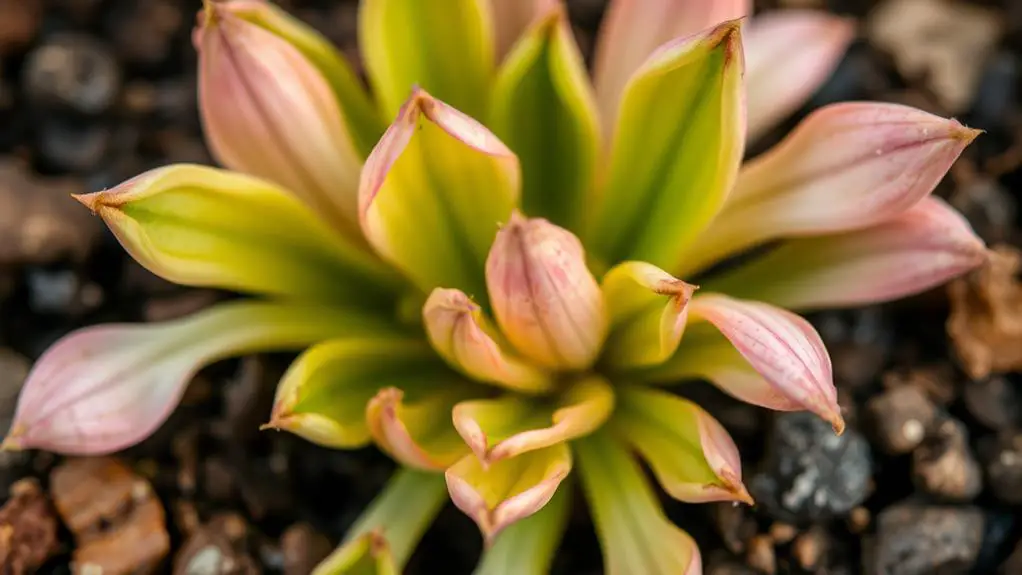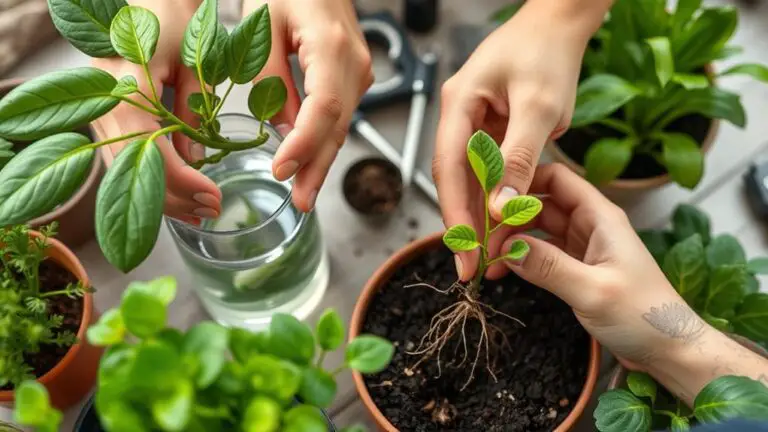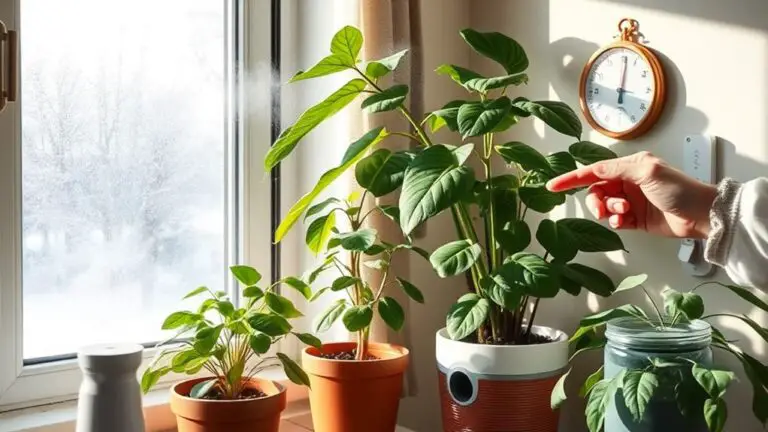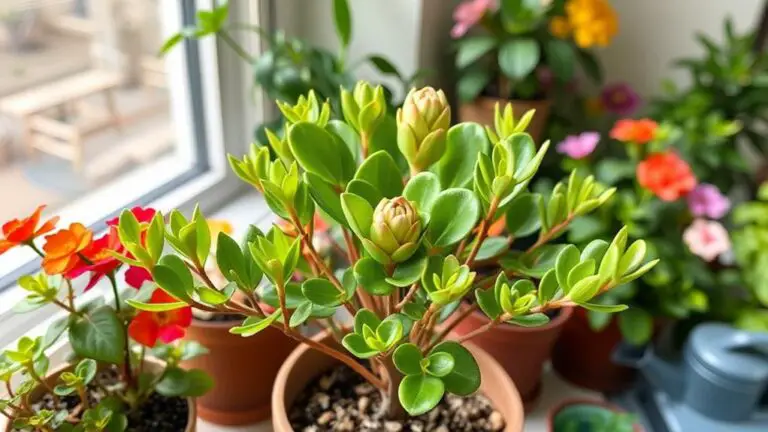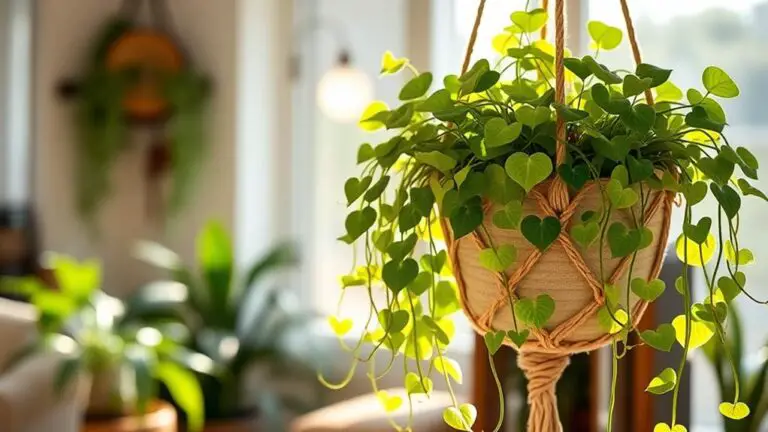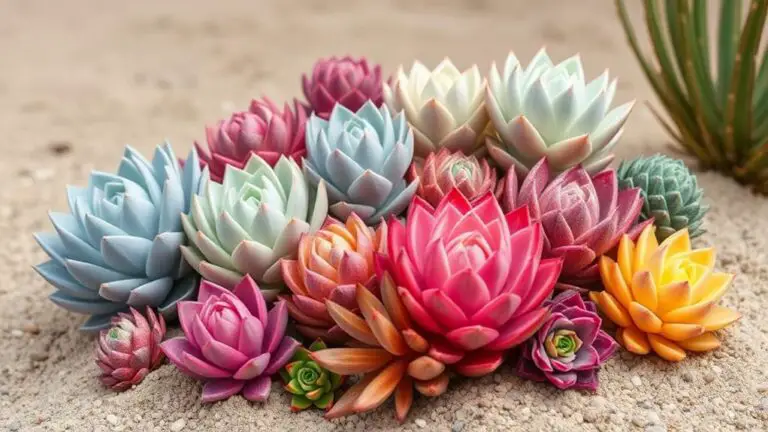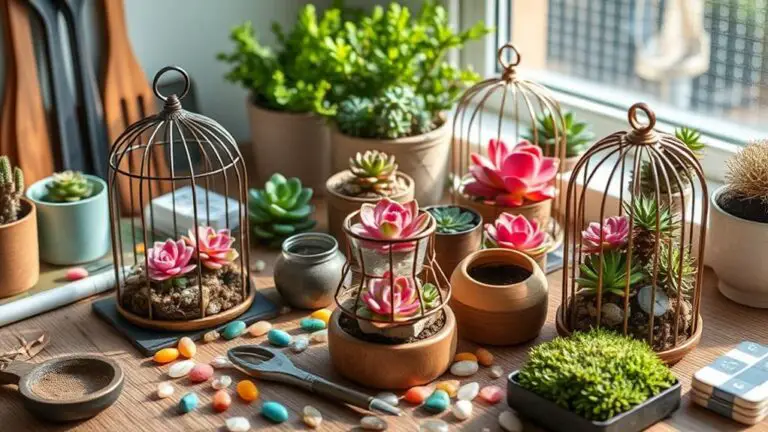7 Common Problems of Pink Lady Callisia Repens
When you bring a Pink Lady Callisia Repens into your home, it's important to understand the common problems that could affect its well-being. You might notice brown leaves, which often result from incorrect watering habits. Sometimes, adjusting your care routine can lead to leaf dropping. Insufficient light can make the plant grow leggy and lose its lovely variegation. Regular pruning is vital to avoid sparse foliage, and nutrient management plays a significant role in vibrant growth. Pests like spider mites and mealybugs can also be problematic. But this is just scratching the surface.
Brown Leaves
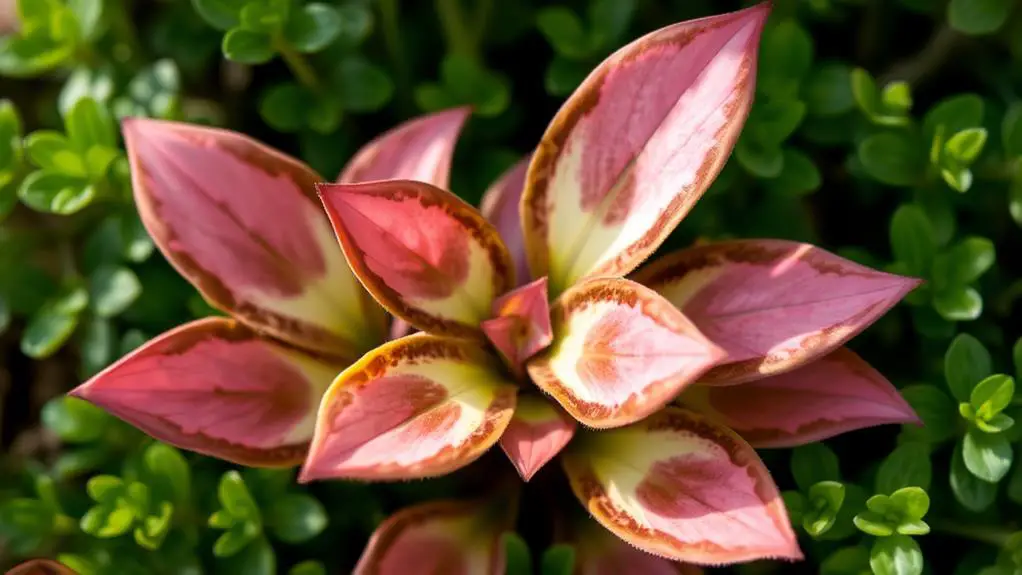
Brown leaves on your Pink Lady (Callisia repens) are often a sign of overwatering, which can lead to root rot and hinder nutrient absorption. When you give the plant too much water, its roots stay wet for too long, causing them to rot. This prevents the plant from taking in the nutrients it needs, resulting in brown leaves.
Conversely, underwatering can also cause browning. When the plant doesn't get enough water, it experiences drought stress. To avoid this, aim for consistent moisture. It's a balancing act—you don't want the soil too wet or too dry. Well-draining soil can help with this, allowing excess water to escape and keeping the roots healthy.
Nutrient depletion is another reason your Pink Lady might sport brown leaves. Make sure the soil has enough nutrients by regularly evaluating and fertilizing it.
Environmental conditions like too much sun or cold drafts can also affect the plant, so keep an eye on where you place it.
To keep your Pink Lady thriving, implement a proper watering routine. Check the soil before watering to verify it needs it. With these steps, you'll maintain a healthy, vibrant plant.
Leaf Dropping
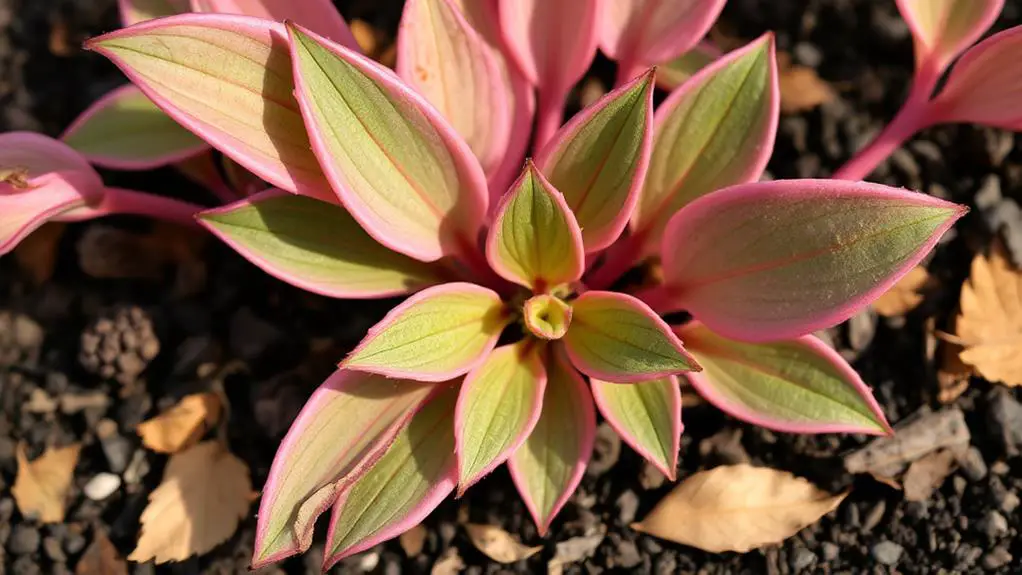
When your Pink Lady Callisia repens starts dropping leaves, it's often a sign that something in its care routine needs adjustment. Leaf dropping can be caused by both overwatering and underwatering. Overwatering leads to waterlogged roots and root rot, while underwatering forces the plant to shed leaves to conserve moisture.
Environmental stressors, like sudden temperature changes or drafts, also play a significant role in leaf dropping. Your plant thrives best in a stable environment. Avoid placing it in areas with frequent temperature fluctuations or exposure to cold drafts.
Regular inspections are essential for spotting pests and diseases early. Infestations weaken plant health and can cause leaves to drop. Check your plant regularly and treat any issues promptly.
To keep your Pink Lady Callisia repens healthy, establish ideal watering routines. Water your plant when the top inch of soil feels dry, avoiding both extremes of overwatering and underwatering. This balance helps maintain the right moisture level, preventing root rot and leaf shedding.
Leggy Growth

Leggy growth in your Pink Lady (Callisia repens) often means it's not getting enough light, so it stretches towards any available source.
To fix this, make sure your plant gets bright, indirect light for several hours a day, and don't forget to prune regularly to encourage fuller growth.
Rotating the plant every so often also helps it grow evenly and prevents one-sided stretching.
Insufficient Light Exposure
Insufficient light exposure is a common issue that leads to leggy growth in Pink Lady (Callisia repens), where the plant stretches its stems in a futile search for sunlight, resulting in sparse and elongated foliage.
If you notice your Pink Lady looking stretched out with fewer leaves, it's likely not getting the bright, indirect light it needs. Ideally, this plant requires at least six hours of such light daily to maintain its compact form.
When placed in low light conditions, your Pink Lady will develop elongated stems with sparse foliage, which diminishes its overall visual appeal and health.
To prevent this, make certain to provide bright indirect light. If a window with sufficient light isn't available, consider using a grow light. Additionally, rotating your plant regularly can help guarantee even light distribution, preventing one-sided leggy growth.
If leggy growth does occur, don't worry! Pruning the excessively elongated stems can stimulate branching and encourage a bushier appearance.
This won't only improve the plant's health but also its visual appeal. With the right light and a bit of care, your Pink Lady will thrive and look its best.
Neglecting Regular Pruning
In addition to insufficient light exposure, neglecting regular pruning can also lead to leggy growth in your Pink Lady (Callisia repens). When you ignore pruning, the stems elongate and the foliage becomes sparse as the plant stretches for light. This results in a less attractive appearance and can compromise the health of your plant.
To encourage bushier growth, you'll need to trim back excessively long stems and pinch the tips of new growth during the growing season. Regular pruning stimulates lateral branching, which helps your plant look fuller and healthier. It's best to perform pruning in the spring or early summer. Use clean and sharp scissors to make precise cuts just above a leaf node.
If you neglect this important task, your Pink Lady might become more susceptible to pests and diseases. Reduced airflow around leggy stems creates a perfect environment for these problems to thrive.
Inconsistent Plant Rotation
Have you noticed your Pink Lady Callisia repens developing elongated, sparse stems? This can often be due to inconsistent plant rotation. When your plant stretches out in search of adequate light, it results in leggy growth.
Here's what you can do to maintain a more balanced appearance:
- Rotate Regularly: Turn your Pink Lady every few weeks to guarantee all sides receive equal light. This helps prevent one-sided growth.
- Trim Excessively Elongated Stems: By cutting back these stems, you encourage bushier growth and denser foliage.
- Monitor Light Conditions: Make sure your plant is getting enough light from all directions. If one side is always in the shadow, rotate it more frequently.
- Inspect for Sparse Foliage: Check regularly for signs of sparse foliage. If you notice any, adjust your rotation schedule.
Inconsistent plant rotation not only affects the plant's appearance but also its overall health.
Regularly rotating your Pink Lady guarantees that all sides of the plant get the light they need, leading to a more balanced and attractive look.
Lack of Variegation

A lack of variegation in your Pink Lady Callisia repens can be frustrating, but it's often due to insufficient light exposure.
Make sure your plant gets plenty of indirect sunlight to maintain those beautiful pink hues.
Additionally, providing a balanced, nutrient-rich diet and regular fertilization every 2-4 weeks during the growing season will help keep your plant vibrant and colorful.
Light Exposure Impact
Proper light exposure is essential for maintaining the vibrant pink hues that make Pink Lady Callisia Repens so cherished. Without enough light, the plant's foliage can lose its beautiful variegation, turning plain green. For your Pink Lady to thrive, it needs bright indirect light for at least six hours a day.
When your plant doesn't get enough light, you might notice leggy growth, where it stretches toward whatever light is available. This stretching makes the plant less bushy and reduces its variegated appearance.
To keep your Pink Lady looking its best, try these tips:
- Place your plant in a spot with bright, indirect light. Avoid direct sunlight, which can scorch the leaves.
- Monitor light conditions regularly. Adjust the placement if you notice leaves losing color.
- Be patient with younger plants. They naturally show less variegation but will improve as they grow with adequate light.
- Rotate the plant occasionally. This guarantees all sides receive equal light, promoting even color development.
Nutrient Deficiency Effects**
Nutrient deficiencies can greatly impact the vibrant variegation of your Pink Lady Callisia Repens. When your plant isn't getting enough nutrients, particularly nitrogen, phosphorus, and potassium, it struggles to develop the beautiful pink hues in its leaves.
This lack of variegation is often noticeable, especially in younger plants, which may naturally show less color until they mature.
To keep your Pink Lady healthy and vibrant, it's important to provide a balanced, vitamin-rich diet. Regular fertilizing every 2-4 weeks during the growing season guarantees your plant gets the nutrients it needs.
This helps support healthy root development, which is vital for overall plant health and leaf appearance.
Don't forget about light exposure, as it's equally important. Without enough light, your plant won't be able to produce those striking colors.
Regular monitoring of both light and nutrient levels is key. Check your plant frequently to make certain it's getting what it needs.
Pest Infestations
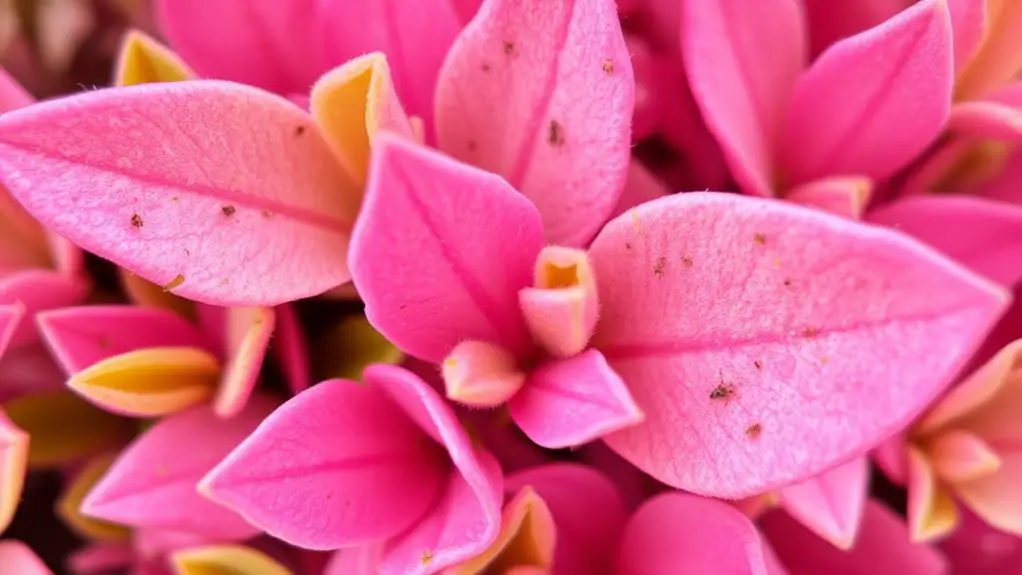
Why do pest infestations plague your Pink Lady (Callisia repens) even with attentive care?
Despite your best efforts, common pests like spider mites, mealybugs, and aphids can still find their way to your plant, leading to weakened plant health.
To help you combat these pesky invaders, let's look at the symptoms and solutions for each.
- Spider Mites: These tiny pests cause stippling marks on leaves and leave behind fine webbing. Act fast to prevent further damage.
- Mealybugs: You'll notice cottony masses on your plant, along with yellowing and curling leaves. They drain nutrients, so treat them promptly.
- Aphids: These bugs gather on the undersides of leaves, causing curling, yellowing, and leaving a sticky substance called honeydew. Clean them off regularly.
- Regular Inspections: Check your plant often and keep its environment clean to prevent infestations.
Fungal Diseases
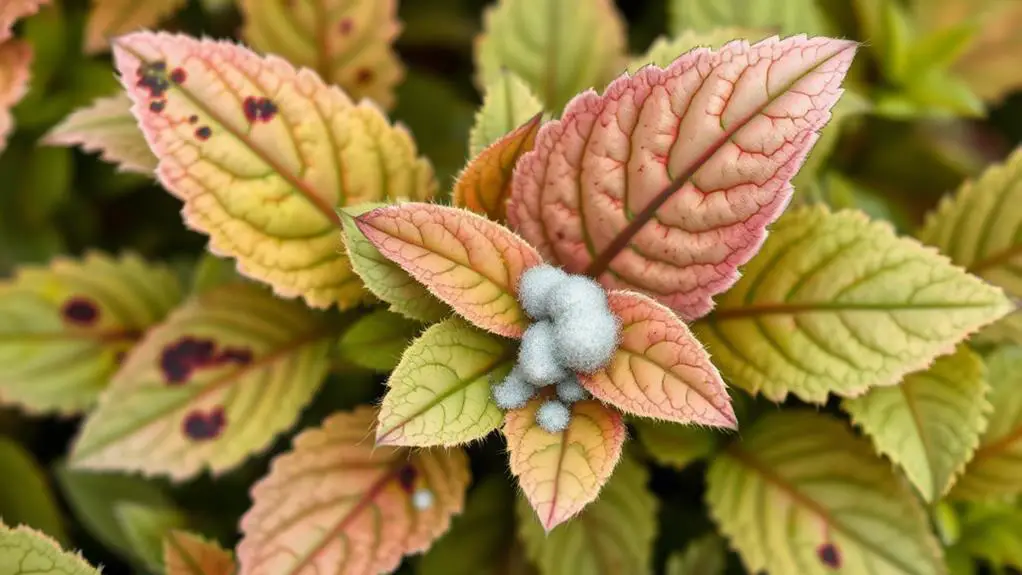
Fungal diseases can greatly impact the health of your Pink Lady Callisia repens. One common issue is root rot, often caused by overwatering and poorly draining soil.
If you notice your plant wilting and its leaves turning yellow, root rot could be the culprit. To prevent this, guarantee your plant has good drainage and avoid waterlogged soil.
Powdery mildew is another problem, appearing as a white, powdery substance on leaves. This fungus thrives in damp conditions and poor air circulation.
To keep your Pink Lady Callisia repens healthy, make sure it gets plenty of airflow and isn't placed in overly humid spots.
Leaf spot disease shows up as dark, circular lesions on leaves. If left untreated, this can lead to yellowing leaves and eventually cause them to drop.
Regularly inspect your plant for these signs, and remove affected leaves to stop the spread.
Environmental Stress
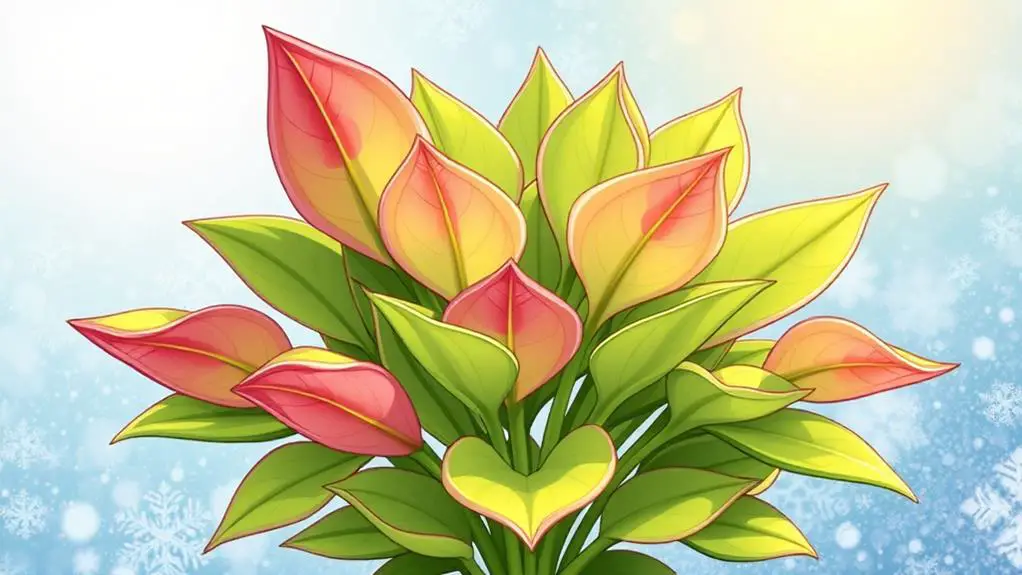
Beyond fungal diseases, environmental stress can also greatly affect the health of your Pink Lady Callisia repens.
It's important to understand how to provide the right conditions to keep your plant thriving. Here are some key factors to take into account:
1. Temperature Fluctuations: Pink Lady thrives in temperatures between 60°F and 75°F.
Temperatures below 50°F can cause significant stress, leading to leaf dropping and overall plant distress. Keep the environment stable to guarantee peak health.
2. Humidity Levels: High humidity levels between 40-50% or higher are preferred.
Low humidity can result in crispy leaf edges and make the plant more susceptible to pests. A humidifier can help maintain the right moisture levels.
3. Bright Indirect Light: Insufficient light can cause leggy growth and fading leaf color.
Your Pink Lady needs at least six hours of bright, indirect light daily for robust development. Place it near a window but away from direct sunlight.
4. Avoid Drafts and Vents: Exposure to drafts or direct heating/cooling vents can negatively impact plant health, causing wilting and browning leaves.
Ensure your plant is in a well-protected spot, away from sudden air movement.
Frequently Asked Questions
What Are the Common Problems With Callisia Repens?
You'll often face overwatering issues, insufficient light causing leggy growth, and pest infestations like spider mites. Environmental stressors such as temperature changes and low humidity can harm it, and nutrient deficiencies lead to yellowing and stunted growth.
Why Is My Pink Lady Plant Dying?
Your Pink Lady plant might be dying due to overwatering, insufficient light, environmental stressors, pests, or nutrient deficiencies. Check if the soil is too wet, make certain it gets enough light, and inspect for pests and temperature issues.
Why Are the Leaves on My Pink Panther Plant Turning Brown?
Your Pink Panther plant's leaves might be turning brown due to overwatering or underwatering. Check your watering routine and soil health. Brown leaves on older growth are normal, but focus on maintaining the health of new growth.
Why Is My Callisia Repens Leggy?
Your Callisia repens is leggy because it isn't getting enough light. Make certain it receives at least six hours of bright, indirect light daily. Prune regularly and rotate the plant to promote bushier growth and even light exposure.
Conclusion
Taking care of your Pink Lady Callisia Repens might seem tricky, but you can handle it! By keeping an eye on watering, light, and pruning, you'll help your plant thrive. Don't forget to watch for pests and provide the right nutrients. If you face any issues, just remember you're not alone; many gardeners have been there too. With a bit of care and attention, your Pink Lady will be healthy and beautiful. You've got this!

